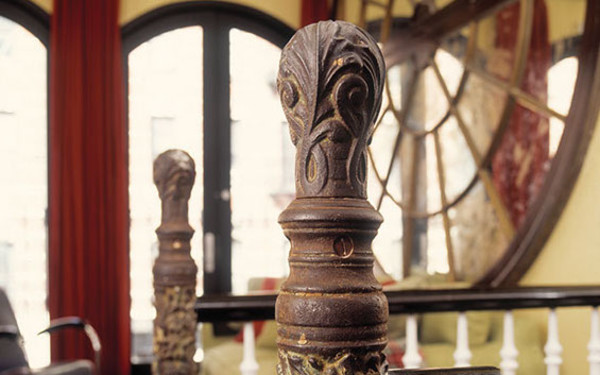
Two Victorian cast-iron newel posts anchor a wood balustrade. (Photo: Dan Mayers)
These homeowners actually built a new townhouse in the heart of Manhattan! Wanting the new construction to fit into the 19th-century neighborhood of brick and terra-cotta buildings, they looked to traditional, time-honored materials and incorporated architectural salvage. For the main level entry greeting visitors inside, there was no better way to avoid a cookie-cutter look than to anchor the staircase with a pair of (slightly) crusty cast-iron newel posts. They’d been salvaged from a demolished Victorian church. The newel posts’ swirling foliate design is a counterpoint to the traditional wood spindles and handrail. Their patina and provenance bring New York’s past into the new building.
Steps to Renewal
1. CLEAN IT UP
With a wire cup brush attached to an angle grinder, layers of old paint and rust were removed. The design was revealed, but enough patina was left to suggest a colorful past. (As always, use heavy gloves, eye protection, and a lead-filtering respirator; a work apron is recommended as the steel brush wires may detach and go through clothing.)
2. CLEAR COAT
These newels then were coated with low-gloss polyurethane, sealing remaining paint and assuring easy maintenance. Another option: Wax and buff the cleaned iron with Johnson’s paste floor wax or carnauba wax to provide a mellow finish that will need periodic reapplication. Had the owners elected to remove all the old paint and rust, newels may have been stripped and powder-coated at a metal shop.
3. INSTALL
Placement was carefully considered; posts often look better an inch or two out from the railing. Height was determined in relation to the rail; newels are typically 40″–45″ above the floor. With surrounding floorboards removed, posts were anchored to floor joists with lag bolts screwed into angle brackets: a newel post is the structural as well as visual anchor of a staircase. Floorboards were refitted around the newels. The handrail was firmly secured to each newel with a pin and fastened with a machine screw; a bolt and rail bracket would also work. The rail may have to be coped or cut into the post profile.







